White Sands Blu-ray Movie
HomeWhite Sands Blu-ray Movie 
Imprint | 1992 | 101 min | Not rated | No Release Date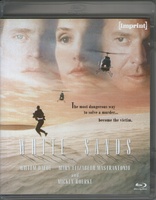
Price
Movie rating
6 | / 10 |
Blu-ray rating
| Users | 0.0 | |
| Reviewer | 4.0 | |
| Overall | 4.0 |
Overview
White Sands (1992)
A small southwestern town sheriff finds a body in the desert with a suitcase and $500,000. He impersonates the man and stumbles into an FBI investigation.
Starring: Willem Dafoe, Mary Elizabeth Mastrantonio, Mickey Rourke, Samuel L. Jackson, M. Emmet WalshDirector: Roger Donaldson
| Thriller | Uncertain |
| Crime | Uncertain |
| Drama | Uncertain |
Specifications
Video
Video codec: MPEG-4 AVC
Video resolution: 1080p
Aspect ratio: 2.36:1
Original aspect ratio: 2.39:1
Audio
English: LPCM 2.0
Subtitles
English SDH
Discs
Blu-ray Disc
Single disc (1 BD)
Playback
Region free
Review
Rating summary
| Movie | 4.0 | |
| Video | 4.0 | |
| Audio | 4.5 | |
| Extras | 4.0 | |
| Overall | 4.0 |
White Sands Blu-ray Movie Review
Reviewed by Dr. Svet Atanasov August 14, 2024Roger Donaldson's "White Sands" (1992) arrives on Blu-ray courtesy of Imprint Films. The supplemental features on the release include new audio commentary by Roger Donaldson and director of photography Peter Menzies; new program with screenwriter Daniel Pyne; new program with editor Nicholas Beauman; and vintage trailer. In English, with optional English SDH subtitles for the main feature. Region-Free.
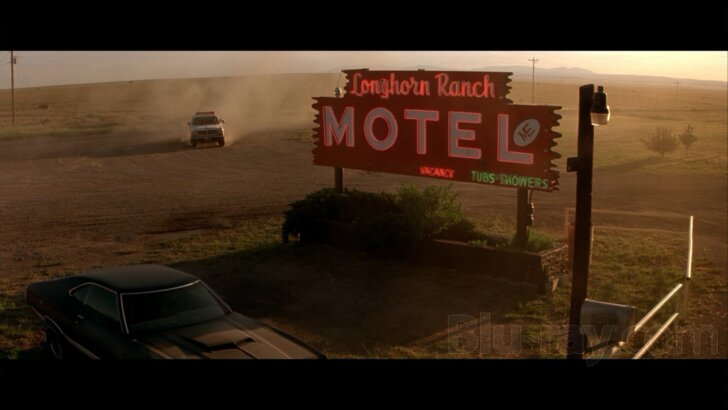
This recent Australian release of Roger Donaldson’s film White Sands will end up being one of my favorite ‘imports’ at the end of the year. There are still a few more months left for exciting announcements, but I just cannot imagine a scenario where one or several other releases will impress me so much that I will forget about its existence. This is how much I like it. It is not because I suddenly discovered White Sands. I saw White Sands theatrically in the 1990s and have liked it ever since. I have an ancient R1 DVD release of it and the recent Region-A Blu-ray release of it in my library, too.
I like this Australian release of White Sands a lot because it has a small but outstanding selection of bonus features, one of which is a phenomenal program with screenwriter Daniel Pyne who sums up the film exactly as I always saw it. In fact, so much of what Pyne mentions matches one hundred percent what I would argue makes White Sands a terrific genre film that it is actually a bit odd. But it should not be. Pyne’s summation of White Sands should have been the most popular take on it in the early 1990s, both with mainstream critics and casual filmgoers.
Here are three key details from the program that I consider to be major strengths of White Sands:
Payne conceived White Sands as a neo-western that was supposed to have a unique connection with a special area in the American Southwest. Payne grew up there and developed an appreciation of landscapes and spaces, which he wanted to explore and transfer to the big screen while writing noir with sunshine. (The French term soleil noir describes this exact practice).
Willem Dafoe’s character was modeled after Gary Cooper’s iconic character from High Noon. It is why initially Payne wanted Walter Hill to direct White Sands. (Virtually all of Hill’s contemporary crime and action films are neo-westerns with a terrific appreciation of landscapes and spaces). When it became obvious that Hill could not commit to White Sands, Donaldson, an Australian filmmaker with a similar style, was approached. Payne credits Donaldson for the looseness that permeates White Sands and establishes the unique connection he was after while writing the screenplay for it.
While a very good jigsaw puzzle with plenty of excellent twists, White Sands is not a film focusing on police procedurals. This is entirely intentional. Payne wanted White Sands to be about identities, one of which was that of the place where its characters meet.
Ancient criticism about the plot being too complex, even unrealistic, must be reevaluated. The plot is excellent and all developments in it, several of which overlap, make perfect sense. After discovering a dead man lying next to a suitcase with half a million dollars in a desert region somewhere in New Mexico, small-town Sheriff Ray Dolezal (Dafoe) begins digging deep and eventually, after learning his name, assumes his identity. Shortly after, he meets shady businessman Gorman Lennox (Mickey Rourke) who needs his money to close a big arms deal and is working with a beautiful mediator (Mary Elizabeth Mastrantonio) expecting to be paid a nice commission. But while impersonating the dead man, Dolezal is forced to assist a veteran FBI agent (Samuel L. Jackson), who has been trying to nab Lennox for years, and improvise to stay alive with the beautiful mediator playing a key part in his plan.
White Sands could have turned out a better film only if Donaldson had chosen to slow it down more and shoot more footage in the desert. However, Payne suggests a couple of crucial sequences were trimmed because of budget limitations, so obviously this was not a viable option.
Donaldson worked with director of photography Peter Menzies, who shortly after lensed The Getaway, Die Hard with a Vengeance, and The 13th Warrior.
White Sands Blu-ray Movie, Video Quality 
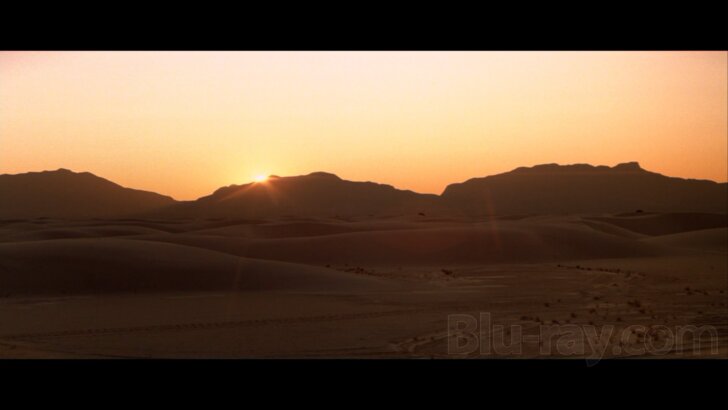
Presented in aspect ratio of 2.36:1, encoded with MPEG-4 AVC and granted a 1080p transfer, White Sands arrives on Blu-ray courtesy of Imprint Films.
I have the recent U.S. release of White Sands in my library and was able to do a few quick comparisons with this release. I could not see any meaningful discrepancies, so I assume that the same master was used to source this release. While it is an older master, it produces good visuals with nice organic qualities. For example, delineation, clarity, and depth remain pleasing throughout the entire film. Darker footage does not reveal distracting crushing. Daylight footage has a few spots where highlights could have been more convincing, but I did not see any troubling anomalies. Color balance is convincing. All colors can be a bit fresher and more vibrant, but I think that only a native 4K presentation with an expanded color gamut can reveal substantial improvements. In 1080p, color reproduction is good. I did not see any traces of problematic digital corrections. However, grain can be healthier and more attractive, and if it is, it will strengthen the dynamic range of the visuals, too. Image stability is very good. (Note: This is a Region-Free Blu-ray release. Therefore, you will be able to play it on your player regardless of your geographical location).
White Sands Blu-ray Movie, Audio Quality 
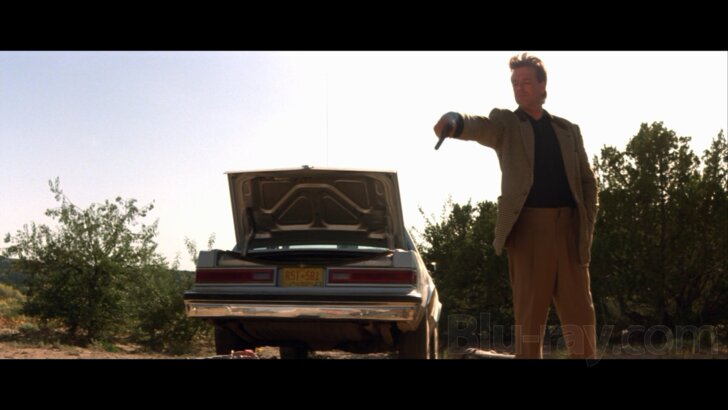
There is only one standard audio track on this Blu-ray release: English LPCM 2.0. Optional English SDH subtitles are provided for the main feature. When turned on, they split the image frame and the black bar below it.
The audio is clean and stable. Regardless of how high you turn up the volume of your system, you will not notice any traces of age-related anomalies. However, I think that a remastering job could strengthen dynamic activity. Why? There is action material that feels like it could be fuller and more aggressive. Of course, I could be wrong, but I suspect that some enhancements could be helpful.
White Sands Blu-ray Movie, Special Features and Extras 

- Commentary - in this exclusive new audio commentary, director of photography Peter Menzies and director Roger Donaldson go down memory lane and recall where and how various segments of White Sands were shot, how light was managed throughout the film, their interactions with different cast members (the comments about Mickey Rourke are quite interesting), the film's noirish identity, etc.
- High Noon Noir - in this exclusive new program, screenwriter Daniel Pyne discusses his love for the American Southwest, his interest in landscapes and spaces, the conception and production of White Sands, the polishing of the film's identity (with comments about sequences that did not make it in its final cut), Roger Donaldson's work on it, etc. It is a fantastic program. In English, not subtitled. (20 min).
- Heart and Soul - in this exclusive new program, editor Nicholas Beauman discusses the early stages of his career in the film industry, the arrival of the offer to work on White Sands, and his interactions with Roger Donaldson while the film was being shot and then finalized. Also, there are some interesting comments about the management of music in the film. In English, not subtitled. (17 min).
- Trailer - presented here is a vintage trailer for White Sands. In English, not subtitled. (2 min).
- Booklet - 60-page illustrated booklet featuring multiple essays and technical information.
White Sands Blu-ray Movie, Overall Score and Recommendation 
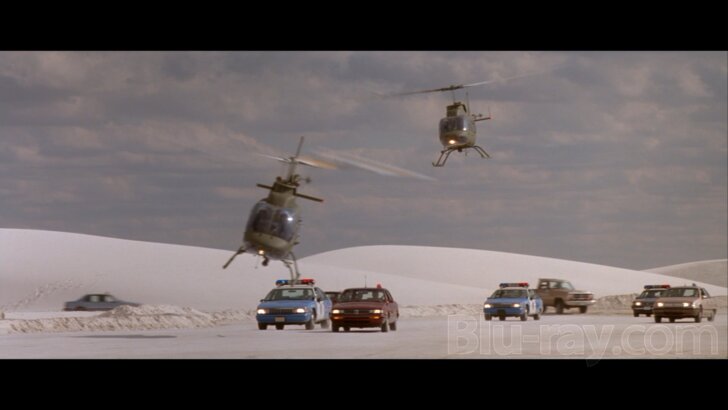
White Sands suffered the same fate The Hot Spot did. However, I cannot think of any good reasons why these films should not be praised as frequently as Blood Simple. They are crafted with the same appreciation of landscapes and spaces that screenwriter Daniel Pyne discusses, and all three are neo-westerns whose memorable characters are engaged in a similar competition for the spotlight with the stunning beauty of the American Southwest. This release has a couple of outstanding exclusive new programs, and currently it is one of my favorite 'imports' of 2024. It is included in After Dark: Neo-Noir Cinema Collection Three, a six-disc, Region-Free box set. HIGHLY RECOMMENDED.
Similar titles
Similar titles you might also like
(Still not reliable for this title)

Rush
1991

No Country for Old Men
2007

U Turn
1997

Under Suspicion
2000

Twilight
1998

Red Rock West
1993

State of Grace
1990

Nocturnal Animals
2016

The Getaway
1972

The Desperate Hours
1955

Swerve
2011

Death on the Nile
Classics Remastered
1978

Electra Glide in Blue
1973

Fargo
1996

Body Heat
1981

White Lightning
1973

The Last Seduction 4K
1994

Blue Steel
1990

The Crossing Guard
1995

The Big Clock
1948